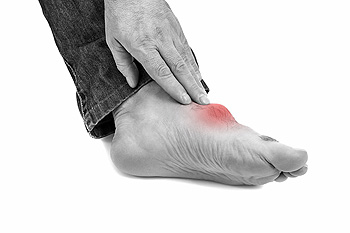The plantar fascia is located on the bottom of the foot. It is a band of tissue that connects the heel to the toes, and if it should become damaged and inflamed, a condition that is known as plantar fasciitis may develop. Common symptoms that are associated with this ailment often include severe pain and discomfort, and it may cause difficulty in walking. It typically originates from overuse from running activities, or as a result of being overweight. Relief may be found when specific stretches are performed that will strengthen the plantar fascia. These consist of stretching the calf, which may be helpful in relieving muscle tightness in the Achilles tendon and heel area. Some patients find it beneficial to roll the arch of the foot on a tennis or golf ball, in addition to pointing and flexing the foot. If you have heel pain, please consult a podiatrist who can guide you toward the treatment that is correct for you.
Plantar fasciitis is a common foot condition that is often caused by a strain injury. If you are experiencing heel pain or symptoms of plantar fasciitis, contact Dr. Luz Colon from Absolute Foot & Ankle Specialists Inc.. Our doctor can provide the care you need to keep you pain-free and on your feet.
What is Plantar Fasciitis?
Plantar fasciitis is one of the most common causes of heel pain. The plantar fascia is a ligament that connects your heel to the front of your foot. When this ligament becomes inflamed, plantar fasciitis is the result. If you have plantar fasciitis you will have a stabbing pain that usually occurs with your first steps in the morning. As the day progresses and you walk around more, this pain will start to disappear, but it will return after long periods of standing or sitting.
What Causes Plantar Fasciitis?
- Excessive running
- Having high arches in your feet
- Other foot issues such as flat feet
- Pregnancy (due to the sudden weight gain)
- Being on your feet very often
There are some risk factors that may make you more likely to develop plantar fasciitis compared to others. The condition most commonly affects adults between the ages of 40 and 60. It also tends to affect people who are obese because the extra pounds result in extra stress being placed on the plantar fascia.
Prevention
- Take good care of your feet – Wear shoes that have good arch support and heel cushioning.
- Maintain a healthy weight
- If you are a runner, alternate running with other sports that won’t cause heel pain
There are a variety of treatment options available for plantar fasciitis along with the pain that accompanies it. Additionally, physical therapy is a very important component in the treatment process. It is important that you meet with your podiatrist to determine which treatment option is best for you.
If you have any questions, please feel free to contact our office located in Miami, FL. We offer the newest diagnostic and treatment technologies for all your foot care needs.
Read more about Plantar Fasciitis
 The medical condition that is referred to as tarsal tunnel syndrome, or TTS, can cause pain and discomfort on the inside of the ankle. It often occurs as a result of nerve damage, which may lead to inflammation. Patients who run or exercise for extended periods of time may gradually experience this type of nerve damage, or it may come from enduring a traumatic injury. Mild relief may be felt by gently stretching the surrounding muscles and tendons, in addition to resting and elevating the affected ankle. This may help to diminish a portion of the swelling. In severe cases, taping the ankle or wearing a brace may provide adequate support as the ankle heals. If you feel you have this condition, it is suggested to consult with a podiatrist who can offer the correct treatment options for you.
The medical condition that is referred to as tarsal tunnel syndrome, or TTS, can cause pain and discomfort on the inside of the ankle. It often occurs as a result of nerve damage, which may lead to inflammation. Patients who run or exercise for extended periods of time may gradually experience this type of nerve damage, or it may come from enduring a traumatic injury. Mild relief may be felt by gently stretching the surrounding muscles and tendons, in addition to resting and elevating the affected ankle. This may help to diminish a portion of the swelling. In severe cases, taping the ankle or wearing a brace may provide adequate support as the ankle heals. If you feel you have this condition, it is suggested to consult with a podiatrist who can offer the correct treatment options for you.
Tarsal tunnel syndrome can be very uncomfortable to live with. If you are experiencing tarsal tunnel syndrome, contact Dr. Luz Colon of Absolute Foot & Ankle Specialists Inc.. Our doctor can provide the care you need to keep you pain-free and on your feet.
Tarsal Tunnel Syndrome
Tarsal tunnel syndrome, which can also be called tibial nerve dysfunction, is an uncommon condition of misfiring peripheral nerves in the foot. The tibial nerve is the peripheral nerve in the leg responsible for sensation and movement of the foot and calf muscles. In tarsal tunnel syndrome, the tibial nerve is damaged, causing problems with movement and feeling in the foot of the affected leg.
Common Cause of Tarsal Tunnel Syndrome
- Involves pressure or an injury, direct pressure on the tibial nerve for an extended period of time, sometimes caused by other body structures close by or near the knee.
- Diseases that damage nerves, including diabetes, may cause tarsal tunnel syndrome.
- At times, tarsal tunnel syndrome can appear without an obvious cause in some cases.
The Effects of Tarsal Tunnel Syndrome
- Different sensations, an afflicted person may experience pain, tingling, burning or other unusual sensations in the foot of the affected leg.
- The foot muscles, toes and ankle become weaker, and curling your toes or flexing your foot can become difficult.
- If condition worsens, infections and ulcers may develop on the foot that is experiencing the syndrome.
A physical exam of the leg can help identify the presence of tarsal tunnel syndrome. Medical tests, such as a nerve biopsy, are also used to diagnose the condition. Patients may receive physical therapy and prescriptive medication. In extreme cases, some may require surgery.
If you have any questions please feel free to contact our office located in Miami, FL. We offer the newest diagnostic and treatment technologies for all your foot and ankle needs.
Read more about Tarsal Tunnel Syndrome Patients who are afflicted with gout often experience severe pain and discomfort in the big toe and surrounding areas. The symptoms that are often associated with this condition can include swelling, tenderness, and inflammation. It is caused by an excess of uric acid in the bloodstream, and this can produce crystals that lodge in the joints of the big toe. Patients who have existing medical conditions may be more susceptible to contracting gout. These can include diabetes, poor kidney function, high blood pressure, and obesity. Additionally, eating foods that are high in purine levels can lead to gout. These can consist of excessive red meat, seafood, and alcohol. If you have this painful condition, it is advised that you seek the counsel of a podiatrist who can properly diagnosis and treat this condition.
Patients who are afflicted with gout often experience severe pain and discomfort in the big toe and surrounding areas. The symptoms that are often associated with this condition can include swelling, tenderness, and inflammation. It is caused by an excess of uric acid in the bloodstream, and this can produce crystals that lodge in the joints of the big toe. Patients who have existing medical conditions may be more susceptible to contracting gout. These can include diabetes, poor kidney function, high blood pressure, and obesity. Additionally, eating foods that are high in purine levels can lead to gout. These can consist of excessive red meat, seafood, and alcohol. If you have this painful condition, it is advised that you seek the counsel of a podiatrist who can properly diagnosis and treat this condition.
Gout is a foot condition that requires certain treatment and care. If you are seeking treatment, contact Dr. Luz Colon from Absolute Foot & Ankle Specialists Inc.. Our doctor will treat your foot and ankle needs.
What Is Gout?
Gout is a type of arthritis caused by a buildup of uric acid in the bloodstream. It often develops in the foot, especially the big toe area, although it can manifest in other parts of the body as well. Gout can make walking and standing very painful and is especially common in diabetics and the obese.
People typically get gout because of a poor diet. Genetic predisposition is also a factor. The children of parents who have had gout frequently have a chance of developing it themselves.
Gout can easily be identified by redness and inflammation of the big toe and the surrounding areas of the foot. Other symptoms include extreme fatigue, joint pain, and running high fevers. Sometimes corticosteroid drugs can be prescribed to treat gout, but the best way to combat this disease is to get more exercise and eat a better diet.
If you have any questions please feel free to contact our office located in Miami, FL. We offer the newest diagnostic and treatment technologies for all your foot and ankle needs.
Read more about Everything You Need to Know About Gout







